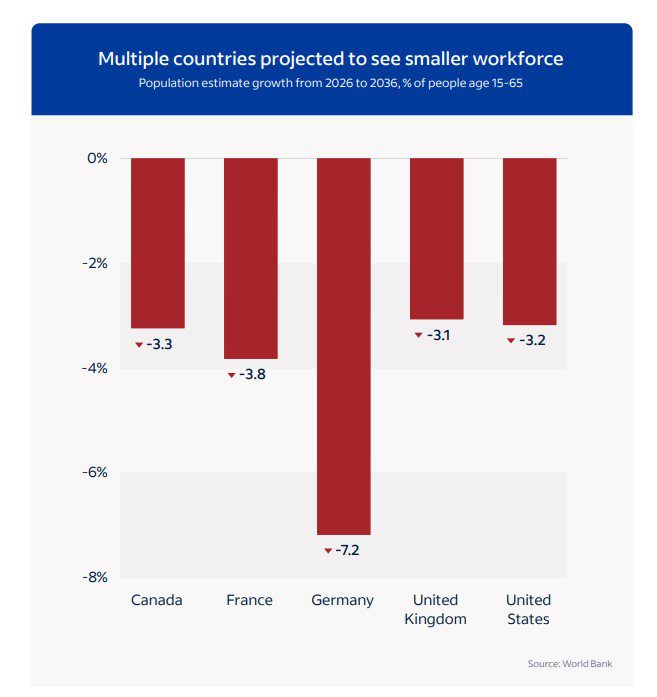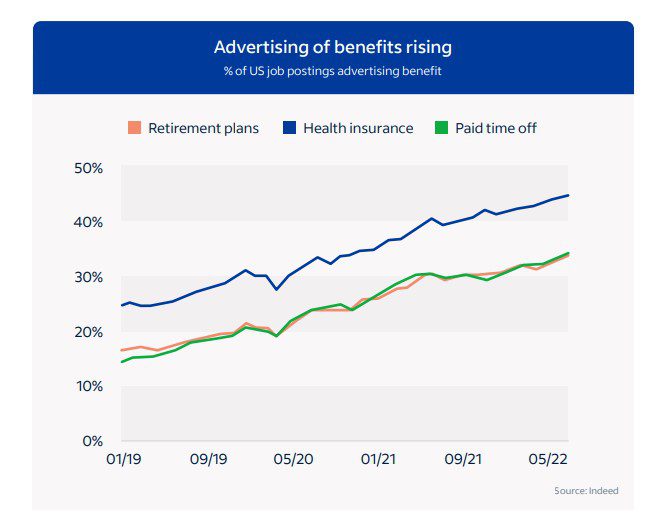Five ways work will change in 2023
HR teams, it’s time to get prepared.
Why You Should Care
COVID-19 changed the world of work forever.
But this begs the question, what will the workplace look like in 2023?
Indeed and Glassdoor teamed up to explore the data and identify the trends that HR teams need to get ahead of.
COVID-19 ushered in a new world of work, and this transformation is set to be permanent.
It is “critical for leaders to understand is that these changes and shifts are not temporary. There will be no return to ‘normal’ that many seem to be awaiting”, noted Indeed Chief Economist Svenja Gudell.
In this context, Gudell’s team at Indeed has teamed up with Glassdoor economists to explore what the world of work will look in 2023 and beyond.
Here are the five trends Indeed and Glassdoor identified. What will the next normal look like?
The tight labor supply will continue, and disrupt hiring
Indeed and Glassdoor’s report is clear that “it is a fundamental error to think that as COVID-19 recedes, hiring difficulties will evaporate.
“Deep-seated and long-term supply dynamics will continue to be a major force that creates a persistent gap between employer demand for new hires and the supply of candidates”.
The main reason for the gap between supply and demand of labor is demographics. The World Bank predicts that the number of people of working age will decline in some of the world’s biggest economies – most notably Germany, Japan, and France.
This situation is worsened by a decline in immigration – for example, the UK is suffering as a result of Brexit, and now deaths are projected to exceed births in just three years. Migration into Germany is also below pre-pandemic levels and contributing to its shrinking labor force.

While there is work for governments to do on immigration policies, including waiving visa rules for certain job types where there are major shortages, what must employers do to grow their hiring pools?
First of all, they need to look at groups of workers who are traditionally overlooked – examples include those with criminal records, or those without university degrees. Examples of employers ahead of the game here at PwC, JP Morgan Chase, Okta and PepsiCo.
Indeed and Glassdoor also recommend that employers think about how they can attract neurodiverse and disabled workers, as well as older workers who might have caregiving responsibilities. There are many reasonable adjustments that can be made to tap into these overlooked, but highly skilled, workers.
Other solutions are to invest in productivity-enhancing technology. The idea is not to replace workers with tech tools – instead, the aim is to use technology to do the boring, manual, administrative tasks that humans do not want to do, and thereby free up workers to do value-adding, meaningful work.
This is something that Zurich’s Sarah Kirby recently shared with UNLEASH the insurer is doing for some of its claim handlers.
The beauty of this use of technology at work is it ties in with some core elements of the war for talent, dubbed the ‘Great Resignation’ i.e. that people want careers, not jobs. They want to do something that is meaningful, and is beneficial to society, and technology can help employers provide that to more of their employees than ever before.
Remote work is going nowhere
It will come as no surprise to many that remote work is here to stay, according to Indeed and Glassdoor’s research.
The number of job postings on Indeed that mention remote work are on the up; they still outpace pre-pandemic levels. In addition, remote work remains a leading reason why employees are looking for new jobs.
This should be a wake-up call for employers who are still resistant to remote work, but the enduring preference for remote work is a huge headache for employers trying to hire for jobs that have to be done in-person.
Only around one in three occupations are actually suitable for remote work – “there will always be a large number of jobs that are not compatible with remote work. Hamburgers can’t be flipped, trucks can’t be driven, and surgery can’t be performed from home offices.”
To solve this problem, many employers have leaned on signing-on bonuses. “In July of 2022 some 5.2% of US job postings on Indeed advertised signing bonuses, more than three times higher than in the same month in 2019, but below the December 2021 peak”, stated the report.
Another solution, which UNLEASH has spoken about with HR leaders at Tyson Foods and Deutsche Bahn who have large employee populations who have to be in-person, is to think about different forms of flexibility.
Could you let people have more choice about their shift patterns? Could you implement more job sharing options? For employers to stay competitive in the ongoing war for talent, they need to get creative.
Rethink benefits if you can’t offer pay rises
Remote work is the second top reason why employees are quitting their jobs; but coming in on top is pay. This is unsurprising given inflation is at record highs across the world – plus the UK is already in a recession, and the European Union and the US is not far behind.
But pay rises may not be affordable for many companies who are also grappling with the looming recession.
So how can employers set themselves apart and sweeten job offers? Lean into benefits, particularly extra paid time off and health insurance.
“Employers in lower paying and in-person sectors will have to stretch if they want to attract job seekers in tomorrow’s labor market, and may need to get a little creative,” stated the report.

Happy employees are less likely to quit
On the topic of healthcare benefits, mental health support is particularly growing in popularity. Stress and burnout reached all-time highs during COVID-19, and workers want their employers to support them during hard times.
The report concluded: “With more choices for workers thanks to a smaller labor pool, employees are demanding greater wellbeing in their experience at work, including increased levels of happiness, satisfaction, purpose, and manageable stress.”

Credit: Indeed’s Work Wellbeing 2022 Insights Report.
Ultimately, employees who are looked after, and happy at work, are more likely to not just be productive, but stay at an organization.
Therefore, to thrive in this environment, “there must be a greater focus on better understanding, measuring, and supporting the wellbeing and happiness of employees”.
D,E&I must be a core HR priority
Indeed and Glassdoor found that diversity, equity and inclusion (D,E&I) are becoming more important to employees than ever. This is primarily because the workforce is getting younger, and younger employees are found to care more about social justice and their employer’s purpose and mission.
Data collected in September 2022 found that 67% of employees aged 18 to 34 would consider turning down a job offer or leaving a company if there was a gender imbalance in leadership – this compares to just 58% of 35 to 44-year-olds and 39 of 55 to 64-year-olds.
Therefore, employers who cut or slowdown their D,E&I efforts could see it directly impact their hiring and retention efforts.
Indeed and Glassdoor’s report concluded: “The workforce of tomorrow will care deeply about DEI initiatives and employers will use these programs to continue to differentiate themselves in a continuously competitive labor market.
“Plus, it’s not only good for workers—it’s good for business and for society.”
Ultimately, for any employers who are looking to get ahead of the future workplace, they need to offer not just a competitive wage, but also “top-notch benefits, positive, engaging company culture, and commitment to DEI initiatives”.
The International Festival of HR is back! Discover amazing speakers at UNLEASH America on 26-27 April 2023.
Sign up to the UNLEASH Newsletter
Get the Editor’s picks of the week delivered straight to your inbox!

Chief Reporter
Allie is an award-winning business journalist and can be reached at alexandra@unleash.ai.
Contact Us
"*" indicates required fields
Partner with UNLEASH
"*" indicates required fields